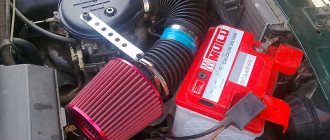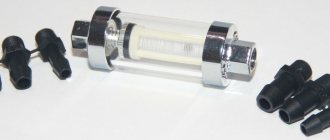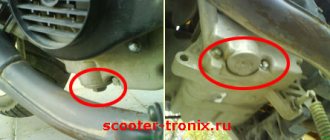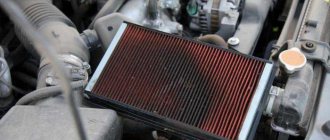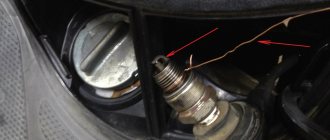Since the beginning of the era of internal combustion engines, engineers have been preoccupied with inventing a device that would purify the air entering the engine.
Over the years, filters have become simpler, more compact and more efficient, and not so long ago the modern zero-resistance filter appeared on the market, which can be found in most sports and racing cars today.
According to the principle of air filtration, it is closer not to simple paper ones, but to oil-based devices that are already outdated today, which were operated in difficult conditions. In them, air passes through a so-called “curtain”, which constantly rotates and is dipped into oil.
Oil traps large contaminants, while fabric mesh is lighter. Modern zero filters, of course, are no longer much like oil filters, but the principle of retaining contaminants due to the oil base has been preserved.
It is worth understanding that if you decide to install a nulevik filter , you need to take care of upgrading other devices in the iron horse.
When tuning an engine, motorists neglect to change the intake system. And this is necessary, since as power increases, more air is required, and, therefore, you cannot do without a zero-resistance filter. It is also recommended to install an enlarged throttle valve, sports camshafts, and bore the cylinders.
Let's take a closer look at the design of the zeros, their features, and maintenance rules.
Installing a zero resistance filter
What is a nulevik?
A zero-resistance filter for a motorcycle or scooter is a conventional air filter designed to protect the cylinders from dust, but has less resistance to air flow (almost zero).
This is achieved by increasing the filter surface area compared to standard filters, which facilitates the passage of air. A conventional air filter is a zero resistance filter
Why do you need a zero? When the piston moves back, a vacuum is created in the cylinder, and air is sucked into it, mixing with gasoline. The more air that can be sucked into the cylinder, the more combustible mixture there will be for operation and the greater the power. However, a filter gets in the way of the air. It creates resistance to air flow, so less air enters the cylinder than it could.
It is impossible to do without a filter, because any dust entering the cylinder causes severe wear. A zero resistance filter avoids these problems. The engine begins to “breathe deeply” and at the same time has full protection from dust.
010_MOTO_0410_062
You can apply the oil with a paint brush.
You can apply the oil with a paint brush.
Impregnating the filter with oil is also a non-trivial task. Beginners make two main mistakes: they saturate the filter unevenly (not only over the area, but also in depth) or overfill the oil, so that after installing the filter it continues to flow out from under the cap for a long time. To prevent this from happening, first carefully pour oil onto the surface of the filter, making sure that it does not leak through (or spray the filter if the lubricant is in a can). As soon as the filter has collected approximately 10–15% of its volume of oil, place it in a transparent plastic bag and gently knead it with your hands, distributing the oil. Impregnation can be considered complete when the filter is evenly colored both outside and inside, and no oil flows out of it when pressed. We squeeze out the excess - we don’t need snot in the airbox, and besides, it can plug the drain valve, an important part on enduro. It is best to let the soaked filter sit for at least a couple of hours, or preferably a day.
Advantages and disadvantages of use
Advantages:
- The main advantage of tuning the air filter (installing a zero filter) is an increase in engine power. This is the most accessible and inexpensive way to get extra “horses” from the engine. Installation does not require any special modifications and can be done independently.
- There are varieties of zero filters that are installed in place of the standard filter, but they are not very effective and often cost more. The most effective models of zero filters do not coincide in size with the standard ones, because they have a large filtering surface. To install them you will have to choose another place.
Increasing engine power is by installing a zero gear
Negative sides:
- One of the difficulties that arises when installing any zero resistance filter is the need to adjust the carburetor. For more air in the cylinder, which is provided by the filter, more fuel is also necessary, because the air-gasoline mixture must be proportional.
- The operation of the carburetor in transient modes (acceleration), when additional enrichment of the mixture is required, is subject to adjustment. If more air is not supplied with more fuel, the engine will lose acceleration dynamics.
- There is one more problem. A real headache for motorcycle owners are low-quality filters. Companies that produce such products simply reduce the density of the filter material instead of increasing the surface area. With a reduced material density, the air actually encounters less resistance, but the filtering effect is also greatly reduced. As a result, dust still gets into the cylinders.
By purchasing a zero-resistance filter from an unknown manufacturer, you risk having to overhaul the engine within a season. Therefore, it is recommended to use zero-resistance filters only from trusted manufacturers.
A zero-resistance filter allows you to avoid problems
DIY air filter
In this article we will talk about restoring the scooter air filter, or rather replacing the filter paper.
How to make an air filter for a scooter
So, I’ll give you a sample of restoring a filter element from a Biwis scooter (do not confuse it with BWS, as they have different motors and filters). First, remove the old filter paper from the element (the edges should be smoothed with a file).
Next, let's go to the auto store and buy an air filter from the Zhiguli. We remove the metal mesh with the cotton strip, we don’t need all this at all. Then we cut the filter with a knife and get a strip.
We cut off the required section of the filter pad.
Remove excess gum from the workpiece.
We insert our workpiece into the nozzle, and glue the edges with tape on both sides (as in the photo). I used reinforced tape because I didn't have anything else on hand; plain plastic tape wouldn't work. We use either paper or reinforced.
Using a hot-melt gun, we completely glue all the edges and check the quality of the seams (sizing). There should be no gaps anywhere, as road sand is terribly treacherous.
And so, we get a filter device (photos from both sides).
That's all, the air filter has been restored. A similar method is used for some 139QMJ motors, where a similar paper filter is installed, only smaller in size. I myself am already in my second season, and everything is fine, the engine consumes gasoline according to the instructions.
Don't forget to replace the filter every 1500-2000 km.
skuterov.ru
004_MOTO_0410_061
The Ural filter also requires maintenance: washing and soaking with clean oil every 15 hours.
Fortunately, consumables are inexpensive. The Ural filter also requires maintenance: washing and soaking with clean oil every 15 hours. Fortunately, consumables are inexpensive.
OIL INERTIA , as on old Urals, must be washed in diesel fuel or gasoline every 15 hours of operation, pour fresh oil into the “pan” and soak the metal filter element itself with oil.
Maintenance of zero vehicles
In principle, servicing tuning filters is no different from servicing standard ones. The filter element is cleaned by blowing air in the direction opposite to suction.
There are also types of filters that can be washed. It all depends on the material from which the zero is made. The possibility of washing is usually indicated by the manufacturer. It is necessary to make a reservation that most of the zeros are still disposable. It is impossible to completely wash out dust particles from a heavily soiled filter. Even after thorough purging or washing, its throughput will be lower than that of a new one.
For washable filters, maintenance boils down to rinsing it in water with a detergent solution and then drying it. The manufacturer specifies what exactly to use for washing.
Important: washing the filter with products not recommended by the manufacturer can damage it!
For engines with insufficient power, such a filter is needed
011_MOTO_0410_062
The filter can be washed from engine or transmission oil with soap and water or washing powder.
For sticky impregnation, it is best to use a special cleaner or white spirit. The filter can be washed from engine or transmission oil with soap and water or washing powder. For sticky impregnation, it is best to use a special cleaner or white spirit.
When squeezing the filter from water or solvents, do not twist it, just squeeze it between your palms. And before impregnation, let it dry thoroughly, otherwise the moisture will remain under the layer of oil. If branded oil is not available, you can use motor oil. True, in this case the degree of
cleaning and water resistance (and foam rubber with good impregnation to a certain extent protects against water hammer - water, unlike air, passes through with difficulty), and - significantly, about ten times - the service life before changing the oil. In addition, engine oil does not adhere well to the filter and flows down over time. The car transmission behaves much better. But special oil pays for itself both due to the duration of operation and due to better filtration. So we’ll leave ersatz impregnations for emergency situations.
How often does it need to be replaced?
The frequency of replacing the air filter depends on the degree of use of the 4 T scooter, as well as the responsibility of its owner and the quality of the roads. If the vehicle is operated on dusty country roads from morning to night, then the period of use of the air purifier will be short.
Average statistical data indicate that it is necessary to change the cleaning structure every 5 thousand kilometers if the vehicle is not used regularly. The service life will also be affected by the quality of the filter itself. Original models will last much longer.
002_MOTO_0410_061
Remove the filter carefully.
Dirt from the joints tends to fall into the engine. A vacuum cleaner will help remove it in advance. Remove the filter carefully. Dirt from the joints tends to fall into the engine. A vacuum cleaner will help remove it in advance.
A gas mask, respirator, gauze bandage are all options for air filters for people. It's hard to breathe with any of them. And if the bandage is too tight, the lack of air becomes more and more intense, oxygen starvation sets in and your strength leaves you. The same thing happens with a motorcycle engine, because the air supply to it directly depends on the condition of the air filter. Therefore, we should not forget about the important duty of any motorcyclist - to monitor the condition of the “lungs” of his ward.
So, the filter cleans the incoming air, but also makes it difficult to move. The dirtier the filter, the less air reaches the cylinder. Here are some typical manifestations of such a malfunction:
• Power is reduced, which is most noticeable when accelerating from medium speeds.
• When you suddenly open the gas at idle, soot comes out of the muffler.
• Increased fuel consumption within 10%.
• It is possible (if the contamination is very strong) that oil loss will increase. This is due to its suction (through seals and the ventilation system) due to the strong vacuum in the intake tract.
On which mopeds or scooters should a zero gear be installed?
First of all, such a filter is needed for engines with insufficient power. This category includes:
- spent motors;
- worn-out motors;
- subcompact.
A separate category includes new, powerful equipment, the owners of which strive to achieve maximum speeds. A nulevik on a motorcycle can give it an increase of several km/h to its maximum speed.
In Russia, small mopeds and scooters are extremely popular due to their low cost. Their power is very low, which does not suit the owners very much. A conventional zero-resistance filter installed on the carburetor allows you to compensate for the lack of power.
It is not always advisable to repair heavily worn motors. They are often fitted with new or contract stock (standard) engines. If the owner is already accustomed to increased power, then the standard “stock” characteristics will no longer suit him. To tune such engines, they usually immediately install a zero.
The filter element is cleaned by blowing air
Pros and cons of installing in a regular place
The advantages include the absence of changes in appearance and design integrity. The standard location is usually hidden by the manufacturer under covers, and the filter is not visible from the outside.
But there are many more disadvantages:
- Hidden installation of the filter under the housings prevents full access of air to the filter. For zero engines this is especially critical, because their purpose is lost - to give the engine as much air as possible.
- In addition, installing the filter under the housing requires the use of an air duct, which is a flexible rubber pipe that runs from the filter to the intake manifold, which integrates the intake, carburetor and cylinder.
- Due to the design features, the air duct most often has a curved shape, so the air flow in it changes direction. Passing through such a pipe also creates resistance to flow. To improve performance, a direct-flow filter for the carburetor is best suited. This type of zero does not require an air duct, has open access to ambient air and is the most efficient.
012_MOTO_0410_062
We saturate the foam filter with oil, kneading it in the bag.
We saturate the foam filter with oil, kneading it in the bag.
And don't forget that air filter oil is sticky, but a foam filter soaked in it feels dry to the touch. And filters coming from the store are sometimes saturated with clear oil. So be careful and don’t get “stuck” like one friend who, out of ignorance, saw a foam filter in a store window, similar in shape to a cap, and immediately pulled it over his head as a joke. It took a good forty minutes to wash the oil out of my hair.
Replacing the air filter on a 4T scooter
Replacing the air filter on a Chinese scooter is a regular and mandatory procedure. Like changing other main spare parts, replacing the air filter requires a responsible approach and step-by-step implementation.
When is replacement required?
High-quality scooter maintenance also depends on timely replacement of the air filter. This element performs an important function - it cleans the air that enters the carburetor. Oxygen then enters the engine along with the fuel mixture. If you hesitate a little, the transport will begin to function inferiorly, disobey its owner and become less playful. Another disadvantage is that if the purifier is clogged, the scooter will begin to consume more fuel, which, of course, will affect its maintenance.
Mechanics recommend changing the air filter on a 4 T scooter every 5 thousand kilometers. It will also be important to clean this element from dust and dirt. Cleaning should be done once every six months.
Cleaning the filter, changing the oil or changing individual system parts is required more often if the scooter is used daily for a long time. In this case, an inspection must be carried out every 500 kilometers. Such actions will eliminate costly repairs and the purchase of spare parts.
Signs that you need to replace the air filter in a 4T scooter:
- clogged appearance of the structure;
- change in technical characteristics of transport equipment:
- slow speed development, the engine does not start immediately, etc.
All these signs indicate that the engine is not getting enough air. It does not matter which scooter requires help (Chinese, homemade or Stealth scooter), the procedure for replacing the cleaner will be the same for each vehicle.
Replacing the air filter on a scooter
The process of replacing the air structure on a scooter begins with determining its type and general characteristics. Another important feature is the location of the air filter.
There is a “wet” type filter, which is most often installed on Chinese models. There are also “dry” cleaners. The latter can often be found on scooters from Japan.
The “wet” filter, which is based on oil- and petrol-resistant foam, is impregnated with special oil.
The design consists of two layers:
- Internal. The material contains small cells that are capable of trapping even the smallest air pollutants;
- External. This layer has large cells that trap massive flows of dust.
The air purifier for the 4 T scooter is mounted in special boxes. This design can be located in front of the carburetor, above the muffler or variator.
Preparing for work
Selecting a suitable filter is the main preparatory stage before replacing the structure. The main rule that will allow you to cope with the task efficiently is that you should not skimp on cleaners. It is better to purchase a more expensive but original version than a fake one. A scooter, like a motorcycle, must quickly respond to the driver’s actions and reach the required speed, which is only possible if you have a high-quality cleaning device.
Required tools for replacement:
- crosshead screwdriver;
- socket wrench;
- pliers;
- clamp
This set of tools will be sufficient for routine filter replacement on a 4 T scooter.
The next step is preparing the new filter for installation. Additional impregnation will help the cleaner cope with its task to the maximum. This can be done using oil or a special chemical. If the choice falls on an aerosol, then it should be applied in linear movements over the entire surface of the filter. It is not recommended to make circular movements, as you should then wait 20 minutes and check the surface for the presence of unimpregnated areas.
009_MOTO_0410_062
Oil for “cross” filters is very sticky and, as a rule, colored so that the uniformity of impregnation can be controlled.
Oil for “cross” filters is very sticky and, as a rule, colored so that the uniformity of impregnation can be controlled.
It is advisable to service the “gauze” filter at least every 4–5 thousand km; with careful handling, it can withstand up to 10 oil changes. For flushing you will need a special product (in extreme cases, you can get by with kerosene or white spirit). The oil used to impregnate these filters is usually bright in color. This is no accident. The fact is that when impregnating, it is important not to miss a single centimeter of the surface, but also not to overdo it. Uniformly pink or blue white gauze is a sign of a well-saturated filter. At the same time, it is unacceptable for the oil to create a visible shine or, especially, to drip from the filter. In very dusty atmospheres, it is better to use a stickier “cross” oil for foam filters.
